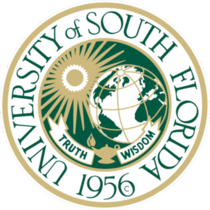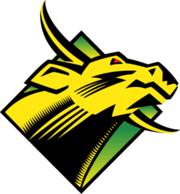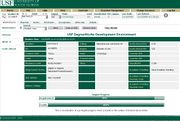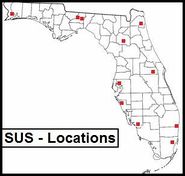University of South Florida
| University of South Florida | |
|---|---|
 Seal of the University of South Florida |
|
| Motto | "Truth and Wisdom" |
| Established | 1956 |
| Endowment | 300 million[1] |
| President | Judy Genshaft |
| Academic staff | 2,358 (2008-09) [2] |
| Undergraduates | 33,951 [2] |
| Postgraduates | 10,311 [2] |
| Location | |
| Colors | Green & Gold ██ |
| Athletics | NCAA Division I, Big East |
| Nickname | Bulls |
| Mascot | Rocky D. Bull |
| Website | http://www.usf.edu |
The University of South Florida, also known as USF, is a member institution of the State University System of Florida, one of the state's three flagship universities, [3]and is a public research university located in Tampa, Florida, USA, with an autonomous campus in St. Petersburg,[4] and branch centers in Sarasota and Lakeland.[5][6][7][8] The main campus is located in North Tampa, near the City of Temple Terrace.
Founded in 1956, USF is the ninth-largest university in the nation and the third largest in the state of Florida, with a total enrollment of 47,122 as of the Fall 2009 semester.[2]
USF is classified by the Carnegie Foundation for the Advancement of Teaching as a "very high research" institution.[9] Furthermore, the university's proposal to create the Florida Center of Excellence for Biomolecular Identification and Target Therapeutics, an $8 million proposal, was ranked highest among all grant proposals considered by the Florida Technology, Research and Scholarship Board in 2006. The Princeton Review ranked the university among the "366 Best Colleges" in the United States. USF is also one of the nation's top centers for the advancement in research of treatments for Alzheimer's, Parkinson's and Huntington's diseases.[10]
Contents |
History

USF was founded in 1956. However, the university was not officially named until the following year, and courses did not start until 1960. Some of the original proposed names included "Citrus State University", "Sunshine State University," "The University of the Western Hemisphere," and "The University of Florida at Temple Terrace".[11] Former US Representative Sam Gibbons was instrumental in the school's creation when he was a state representative and is considered by many to essentially be the school's founder. It was built on the site of Henderson Air Field, a World War II airstrip. Although located in west-central Florida, at the time of establishment USF was the southernmost public university in the State of Florida, a geographic situation that lent USF its sometimes confusing name.
The university grew under the leadership of John Allen, who served as its first president from 1957 until his retirement in 1970. During this time, the university expanded rapidly, due in part to the first graduate degree programs commencing in 1964. Under Allen's leadership, USF touted itself as the "Harvard of the South". Allen was known for his opposition to college sports in favor of an environment more academically centered. Today, the main administration complex is called The John and Grace Allen Center, named after him and his wife.[12]
USF emerged as a major research institution during the 1980s under the presidency of John Lott Brown[13] President Brown appointed scholarly administrators such as James F. Strange, Dean of Arts and Letters, and Andor Szentivanyi {"The Beta Adrenergic Theory of Asthma"} Dean of Medicine. He also recruited basketball coach Lee Rose, one of the most popular coaches in Bulls history.
Two university hospitals, The H. Lee Moffitt Cancer Center and USF Psychiatry Center, as well as the college of public health, were built during Brown's presidency. The Brown administration planned for an on campus children's hospital that never materialized and eye institute that opened after Brown's retirement.
Brown's final accomplishment was giving Andor Szentivanyi authority to create a second Department of Pediatrics at All Children's Hospital under the leadership of Time coverman Robert A. Good while simultaneously obtaining a Certificate of Need for a Tampa Children's Hospital.
USF played its first football game in 1997. Its marching band, the Herd of Thunder formed in 1999.[14]
USF System
USF System Campuses
The University of South Florida System has four institutions: University of South Florida, USF St. Petersburg, USF Sarasota-Manatee and USF Polytechnic. There is also a downtown center in downtown Tampa.[15] A fourth satellite campus, in Fort Myers, was in operation from 1974 until 1997 when campus operations were folded into the new Florida Gulf Coast University.[16]. The Fort Myers campus was at the time shared with Edison College, and Edison now controls the entire campus.
Lakeland campus
USF Lakeland was established in 1988, it serves over 2,000 students offering over 20 complete undergraduate and graduate degrees through the areas of arts and sciences, business, education, engineering, and information technology. The campus also supports a number of individual classes, electives, web-based courses, certificate programs and program partnerships with the main campus in Tampa.[17]
Sarasota-Manatee campus
USF Sarasota-Manatee was established in 1975, and shared a campus with the New College of Florida.[18] New College and USF Sarasota-Manatee continued to share campuses until a new campus was built for USF Sarasota Manatee. The new campus opened on August 28, 2006.[19]
St. Petersburg Campus
USF St. Petersburg was established in 1965 in downtown St. Petersburg, Florida as the "Bayboro Campus". In 2006, USF St. Petersburg was accredited as a separate entity within the University of South Florida system by the Southern Association of Colleges and Schools starting with the 2006–2007 school year.[4]
Administration and organization
Presidents
| Presidents[20] | |||||
|---|---|---|---|---|---|
| Person | Years | Person | Years | ||
|
|
|
|
|
||
|
|
|
|
|
||
|
|
|
|
|
||
|
|
|
|
|
||
|
|
|
|
|
||
|
|
|
|
|
||
Student government
The Student government, like all Florida student governments, is an agency of the state created under Florida Statute 2004.26. The student government is responsible for advocating for students at the university, local, state and national levels, provides enhancements to student life on and off campus, and the Student Senate allocates and expends over $10 million in Activity and Service fees a year by Florida law. The student government is set up much like the federal government and is bound by the Student Body Constitution, student government statutes, university regulations, and applicable law. The student government employs over 200 students and is housed in the Marshall Student Center building.
The executive administration, headed by the student body president and vice president, oversees several departments (Department of Government Affairs, Department of University and Community Affairs, Department of Student Life and Traditions, Office of Legal Affairs, Department of Student Services, Office of Management and Budget, Office of Public Affairs, and the Department of Marketing and Communications) and service agencies (SAFE Team, Student Government Computer Services, and Bulls Radio) which allow them to carry out their duties. The Student Body President sits on the University Board of Trustees and is a member of the Florida Student Association (FSA). In accordance with the Florida Constitution, the chair of FSA (elected by all other student body presidents) is a member of the Florida Board of Governors which oversees the State University System of Florida.
The student senate, headed by the senate president and senate president pro-tempore, is the voice of the student body, which creates legislation and allocates and expends activity and service fee funds per Florida Statute 1009.24. The senate has 60 seats that are filled by the college. Each college is allotted a certain numbers of seats depending on the size of the college. The Senate carries out its duties mostly through committees. The Senate Executive Committee (SenEx) is made up of the senate president, senate president pro-tempore, and all standing committee chairs and oversees administrative functions of the Senate.
The student supreme court, headed by the chief justice, hears cases involving students and student government and also hears all final parking appeals for students at the Tampa campus.[21]
The SAFE Team Agency is dedicated to providing a heightened level of safety at the University of South Florida. They provide this service by constantly patrolling parking lots throughout the evening and into the early morning, watching for illegal activities. SAFE Team also provides students with a safe and free escort around the campus.
Academics

In the 2006-2007 academic year, the university awarded 9,202 degrees: 6,743 undergraduate degrees, 2,095 graduate degrees, 18 education specialists degrees, 219 doctoral degrees and 116 first professional degrees.
In fall of 2006, the university had a 80 percent freshman retention rate. The student-to-faculty ratio was reported as being 19:1. Also for that year, the six year graduation rate was 49 percent (Fall, 2000).[22] For the fall 2007 semester[update], of the total student population, there were 34,447 undergraduate students (75 percent), 8,338 graduate students (19 percent), 1,980 non-degree seeking students (4 percent) and 479 medical students (1 percent).[10] As of 2007[update], the university offers: 89 undergraduate degrees programs, 91 master degree programs, 2, Ed Specialist degrees, 36 Doctoral Degrees and one First Professional degree (MD).
87 percent of USF faculty members hold terminal degrees: 28 hold endowed professorships and 62 are Distinguished University Professors. There is a total of 1,937 instructional faculty members, 1,303 adjunct professors, and 183 post-doctoral appointees. The student faculty is composed of 1,763 graduate assistants and 2,419 student assistants. (Figures are for the 2006-2007 academic year).
Student profile
As of the fall 2007 semester[update] the student ethnicity profile of the university consisted of: 65 percent white students (29,578), 12 percent African American students (5,277), 12 percent Hispanic students (5,331), six percent Asian/Pacific Islander (2,582), one percent American Indian (201) and five percent of students did not report (2,325).
The Princeton Review has ranked the university 17th in nation for diversity among students.
As of the fall 2007 semester[update] the international student population of the university consisted of 541 undergraduate students, 827 graduate students, and 102 non-degree seeking students, totaling 1,470 international students representing 127 countries.
The class of 2013 earned admission to the university with academic credentials of a middle 50 percent SAT score range of 1110 to 1280 and middle 50 percent high school GPAs of 3.58 to 4.13. While official enrollment figures will not be available until the end of the first day of classes on Aug. 24, USF estimates approximately 4,250 students will be part of the freshman class.
Colleges, schools and institutions
USF has 18 colleges, schools, and institutions.[23] Seven colleges offer undergraduate degrees.
Arts
USF's Contemporary Art Museum features regular exhibitions of contemporary art, including a show of faculty work every three years and an annual juried student show. USF also operates Graphicstudio, an art studio and print shop which has hosted artists like Roy Lichtenstein, Robert Rauschenberg, James Rosenquist, and Allan McCollum. Regular exhibitions of student work are featured in the William and Nancy Oliver Gallery and the student-run Centre Gallery in the Marshall Center. The School of Art & Art History is the premier school in the state of Florida. One of its staple events is called "ArtHouse" on the same night as the annual juried student show where all of the student studios are open with current work on display for people to walk through.[24]
School of Music
USF's School of Music has been steadily growing since the university opened in 1956. In 2006 the School of Music held the first annual Robert Helps Festival and Composition Competition. The festival and competition is named for the late piano and composition professor Robert Helps and is held the second week in February. The international composition competition is for young adult composers and features a $10,000 prize and premieres of the winning work during the festival at USF. The festival includes masterclasses, presentations and lectures from renowned musicians in addition to nightly concerts performed by students and faculty, including the traditional Valentine's Day concert started by Robert Helps featuring the USF faculty. The 3rd annual Robert Helps Festival included master classes and lectures by Augusta Read Thomas, David del Tredici, Wes York, Vivian Perlis, and Carol Rodland.
On January 29, 2009 the School of Music broke ground on a New 104,000 sq. ft. music and performance hall that is slated to open spring of 2011.
ROTC
USF is one of only 38 institutions that host all three (Army[25] , Naval[26] and Air Force[27] ) ROTC programs. With almost 400 students enrolled in the programs and proximity to three major military commands (Central Command, Special Operations Command and Southern Command), the University became the home of the nations first Joint Military Leadership Center (JMLC). The Center is charged to provide the student cadets/ midshipmen and officer candidates with unique (Joint, Multinational, and Interagency) core competencies and skills in leadership development, global understanding, and military/national defense strategies. The "end state" of the Center's actions is an academically-structured, research based, and values-driven program that educates, trains and prepares military Officers and Service Leaders for their leadership roles in the continuing transformation of the United States Armed Forces and in a dynamic and challenging global environment.
Center for Urban Transportation Research (CUTR)
The Center for Urban Transportation Research (CUTR) is located next to the USF College of Engineering on the USF Tampa Campus. CUTR, established in 1988, is nationally recognized and serves as an important resource for policymakers, transportation professionals, the education system, and the public. With emphasis on developing innovative, implementable solutions to transportation problems, CUTR provides objective transportation expertise in the form of technical support, policy analysis, and research support for its project sponsors.
A significant factor in CUTR's success is the faculty of full-time employees dedicated to conducting research. The multidisciplinary research staff includes experts in economics, planning, engineering, public policy, and geography who develop comprehensive solutions for all modes of transportation while combining academic and "real world" experience.
CUTR conducts $8 million in research annually for a variety of public and private sector sponsors in Florida and the United States, including the Florida Legislature, the Florida Transportation Commission, and state and local governments, agencies, and organizations. Areas of research include public transportation, transportation planning, intelligent transportation systems (ITS), transportation demand management (TDM), transportation economics and finance, geographic information systems, access management, alternative fuels, and transportation safety, among others.
CUTR houses the National Center for Transit Research (NCTR), designated by the U.S. Congress in 1991 and reaffirmed in 1998 and in 2002, and the National Bus Rapid Transit Institute, sponsored by the Federal Transit Administration and in partnership with the University of California-Berkeley. Through NCTR and NBRTI, CUTR conducts research projects in rapidly growing urban areas to develop innovative, pragmatic approaches that will enable public transportation to better meet the evolving needs of U.S. citizens.
CUTR has been criticized for political corruption by Florida state senators.[28]
Libraries
The USF Libraries consist of six libraries: the Tampa Library on the main campus; the Poynter Library on the St. Petersburg campus; the Jane Bancroft Cook Library on the Sarasota campus; a new library on the Lakeland campus; and the special libraries. The special libraries are the Shimberg Health Sciences Library and the Florida Mental Health Institute Research Library.
Student life
Housing
Despite the rise in demand for on-campus housing, only thirteen percent of USF's student body (approximately 5,200 students) lives in a university residence hall. Many students find it more cost effective and desirable to live in area apartment complexes that cater to students. These "resident commuters" make up the majority of the student body.
In recent years, Housing and Residential Education relinquished control of The Edge, a high rise residential hall located outside campus boundaries.
Then Andros Complex, on-campus housing, was built from 1960 to 1965. Each hall was named after a Greek letter.[30][31][32] During this period, an ambitious fundraising campaign called "Dollars for Dorms" was initiated and appealed to individual and business interests in the Tampa Bay area.[33] Older residence halls, such as Beta Hall (which houses freshmen only), Betty Castor Hall (formerly Gamma Hall, women-only),[34] and Kosove Apartments (formerly Alpha Hall, upperclassmen)[35] received extensive remodeling in the early 2000s. The other Greek letter residence halls (named in order from Delta to Mu) are built in a confined community area known as the Andros Complex.
Newer housing subdivisions, such as the Cypress Suites and Apartments, Maple Hall, Holly Apartments, Greek Village and the Magnolia Apartments, were built in the late 1990s. The last of them, the Cypress complex, was completed in the summer of 2004. Juniper-Poplar Hall, formerly Magnolia Hall, opened August 7, 2009 adding 1,050 beds to USF and a new dining hall on the first floor.
Additionally in Fall 2009 USF will require all incoming freshman to live on campus their first year at the college. Students exempt from this new rule include students who remain living with their parents and/or legal guardians within Hillsborough, Pasco, and Pinellas counties, students above the age of 21 by the first day of fall classes, students with a dependent child or family member, or students who are married.
Greek life
USF has a very large community centered around Greek life, comprising of a number of fraternities and sororities. Listed below are the fraternities and sororities sponsored by USF, and the years in which they were founded on the campus.[36][37]
Fraternities
|
|
Sororities
- Alpha Delta Pi 1967,
- Alpha Kappa Alpha 1972
- Alpha Kappa Delta Phi 2006
- Alpha Omicron Pi 1985
- Chi Omega 1968
- Chi Upsilon Sigma 2007
- Delta Delta Delta 1966
- Delta Gamma 1969
- Delta Phi Omega 2004
- Delta Sigma Theta 1973
- Kappa Delta 1967
- Lambda Theta Alpha 1998
- Lambda Psi Delta 1999
- Sigma Delta Tau 1987
- Sigma Gamma Rho 1981
- Sigma Lambda Gamma 1995
- Sigma Sigma Rho 2002
- Zeta Phi Beta 1980
- Zeta Tau Alpha 2003
Traditions
Alma mater
:Hail to Thee, our Alma Mater[38]
- May thy name be told,
- Where above thy gleaming splendor,
- Waves the green and gold.
- Thou our guide in quest for knowledge.
- Where we all are free
- University of South Florida,
- Alma Mater, Hail to thee!
- Be our guide in truth and wisdom
- As we onward go,
- May thy glory, fame and honor
- Never cease to grow;
- May our thoughts and prayers
- be with thee through eternity,
- University of South Florida,
- Alma Mater, Hail to thee!
Golden Brahman March (fight song)
:USF Bulls are we,[39]
- We hold our standard upright and free.
- For Green and Gold we stand united.
- Our beacon lighted and noble to see.
- USF Bulls are we,
- For USF will always be.
- With all our might we fight the battle
- here and now, and we will win the victory!
- (shout!) S-O-U-T-H F-L-O-R-I-D-A
- South Florida, South Florida
- Go Bulls!
University and student media
Beginning in 1961, USF's first student newspaper was the Campus Edition of The Tampa Times, a now defunct local afternoon newspaper. It was succeeded by The Oracle which was first published on September 6, 1966 as a weekly.[40] Today The Oracle is published four times a week (previously five, due to budget cuts) and has a circulation of more than 12,000.
In spring of 2009, a newspaper known as the Monocle began.[41]
The student radio station, Bulls Radio, is located in the Marshall Student Center.[42]
In 1963, the school began to operate WUSF, an FM station which offers classical and jazz music and National Public Radio (NPR) programming.
The major television studio associated with USF is WUSF-TV studios. The station is funded by local corporate and private contributors as well as the Corporation for Public Broadcasting (CPB) and is affiliated with the Public Broadcasting Service (PBS). It has been serving the Tampa Bay area for nearly 50 years. Full-time employees as well as part-time student trainees and those seeking mass communication course credit staff the state-of-the-art facility.[43]
Athletics
The South Florida Bulls compete in NCAA Division I, USF is a member of the Big East Conference, and has been since 2005. The university currently sponsors varsity sports: baseball, men's and women's basketball, golf, football, men's and women's soccer, softball, tennis, cross country, track, volleyball, sailing.
Notable alumni and attendees
See also
- H. Lee Moffitt Cancer Center & Research Institute
- Raymond James Stadium (home stadium of the Tampa Bay Buccaneers, used by the South Florida Bulls for football games)
- University of South Florida Botanical Gardens
- Graphicstudio
- USF Sun Dome
- WUSF (FM)
- WUSF-TV
- WSMR (FM)
- Bulls Radio
References
- ↑ [1]
- ↑ 2.0 2.1 2.2 2.3 USF Pocket Facts, 2009
- ↑ http://www.coedu.usf.edu/main/news/2010/FloridaPROMISE.html
- ↑ 4.0 4.1 About USF St. Petersburg
- ↑ USF Campuses
- ↑ Tampa Campus Services
- ↑ Two local residents honored at USF Tampa fall 2001 commencement ceremoniesWeb archive
- ↑ Distance Learning
- ↑ ""Carnegie classification"". http://carnegiefoundation.org/classifications/sub.asp?key=748&subkey=13889&start=782. Retrieved February 6, 2009.
- ↑ 10.0 10.1 USF Pocket Facts
- ↑ USF Site, Name Stirred Struggles
- ↑ Reflections on the John Allen Legacy
- ↑ Honorary Committee Biographies
- ↑ From the beginning... The History of the Herd of Thunder Athletic Bands
- ↑ Campuses
- ↑ A9505_1.PDF
- ↑ About USF Lakeland
- ↑ 2007 Quick Facts USF Sarasota-Manatee
- ↑ About the new USF Sarasota-Manatee campus
- ↑ Hall of Presidents
- ↑ "Home". http://www.sg.usf.edu. Retrieved 2008-07-20.
- ↑ USF Pocket Facts
- ↑ Academics
- ↑ www.art.usf.edu
- ↑ "Army ROTC:
It's How Students Become Leaders". http://armyrotc.com/edu/univsouthfl/index.htm. Retrieved 2008-07-20. - ↑ http://web.usf.edu/nrotc/usfnrotc.htm
- ↑ "AFROTC Detachment 158, University of South Florida". http://web.usf.edu/~airforce/. Retrieved 2008-07-20.
- ↑ [2]
- ↑ Beta Hall
- ↑ Suite-Style Residence Halls
- ↑ Greek Village
- ↑ Traditional-Style Residence Halls
- ↑ University of South Florida: The First 50 Years
- ↑ Castor hall
- ↑ Kosove Apartments
- ↑ USF Interfraternity Council
- ↑ USF Panhellenic Council
- ↑ History of the USF Alma Mater
- ↑ Bulls’ Football Stands Spirit
- ↑ In the Beginning...
- ↑ WordPress.com.
- ↑ Phyllis Marshall slept here - 40 Years of Memories
- ↑ About WUSF Public Broadcasting
External links
- Official USF website
- Official athletics website
- USF Digital Special Collections, Open Access and full text of many rare books, maps, and more
- USF Libraries on YouTube
- USF's Contemporary Art Museum
|
|||||||||||||||||||||||
|
||||||||||||||||||||||||||||||||
|
||||||||||||||||||||
|
|||||||||||||||||
|
||||||||

